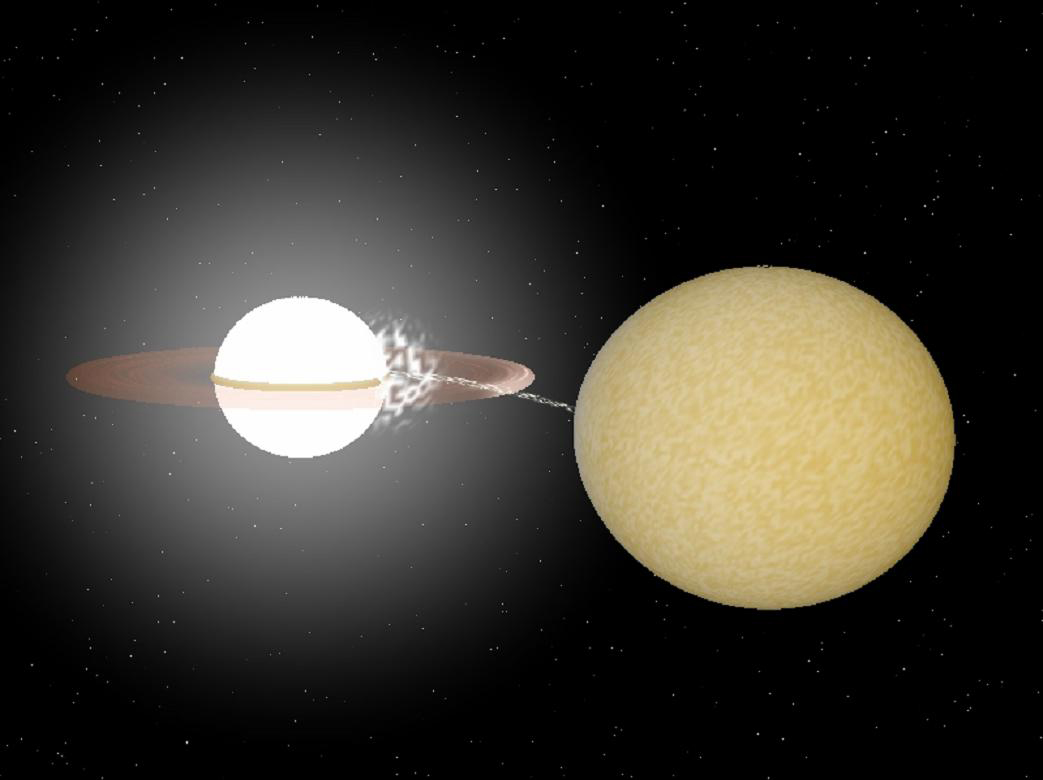Mauna Kea, HI — Astronomers using the W. M. Keck Observatory have identified the smallest known binary system to date. The system, called HM Cancri, consists of two dead stars that revolve around each other in 5.4 minutes, by far the shortest known orbital period of any pair of stars.
The team, led by Gijs Roelofs of the Harvard-Smithsonian Center of Astrophysics, used the 10-meter Keck I telescope with its Low Resolution Imaging Spectrograph to study the velocity changes in the spectral lines in the light of HM Cancri. They observed that as the stars orbited each other, the system’s spectral lines shifted periodically from blue to red and back following the Doppler Effect. With the velocity information, the astronomers were able to confirm the binary’s 5.4-minute period. The results appear in the March 10 Astrophysical Journal Letters.
“When the first data from the Keck telescope arrived, and our quick analysis showed the periodic shift of the spectral lines, we knew that we had succeeded. More than ten years after its discovery, we finally had deciphered the nature of HM Cancri,” said Arne Rau of the Max Planck Institute for Extraterrestrial Physics in Garching, Germany, who led the observations at Keck.
Astronomers proposed several years ago that HM Cancri was an interacting binary consisting of two dead stars and that the 5.4 minute period observed was indeed the orbital period. “It is very gratifying to see this model confirmed by our observations, especially since earlier attempts had been thwarted by bad weather,” said Daniel Steeghs of the University of Warwick, UK. The team had been trying to make precise velocity measurements to confirm the period since 2005.
HM Cancri was discovered in 1999 as a weak X-ray source in data from the German ROSAT satellite. It consists of two white dwarfs, burnt-out cinders of stars that were once similar to the Sun and contain a highly condensed form of helium, carbon and oxygen. In 2001, the X-ray, and also optical, data suggested that the two stars orbited each other in 5.4 minutes.
But this information suggested that the binary system was roughly eight times the diameter of the Earth—equivalent to a quarter of the distance between the Earth and the Moon—or smaller. Astronomers were reluctant to accept this physical description of HM Cancri without additional evidence. But even at a distance of 16,000 light years from Earth, the binary system shines only one millionth as bright as the faintest stars visible to the naked eye.
To determine with certainty the period of such a system, astronomers needed to use world’s largest telescopes to collect the additional evidence. “This type of observation is really at the limit of what is currently possible. Not only does one need the biggest telescopes in the world, but they also have to be equipped with the best instruments available,” said team member Paul Groot of the Radboud University Nijmegen in the Netherlands.
As a result of the successful observations with Keck, astronomers now have a new cosmic laboratory to study the evolution of stars as well as general relativity. “We know the system must have come from two normal stars that somehow spiraled together in two earlier episodes of mass transfer, but the physics of this process is very poorly understood,” said Gijs Nelemans of the Radboud University who was also part of the team.
He added that the system must be one of the most copious emitters of gravitational waves. “We hope to detect these distortions of space-time directly with the future LISA satellite. HM Cancri will now be a cornerstone system for the mission,” he said.
The W. M. Keck Observatory operates two 10-meter optical/infrared telescopes on the summit of Mauna Kea on the island of Hawai’i and is a scientific partnership of the California Institute of Technology, the University of California and NASA. For more information please call 808.881.3827 or visit http://www.keckobservatory.org.


